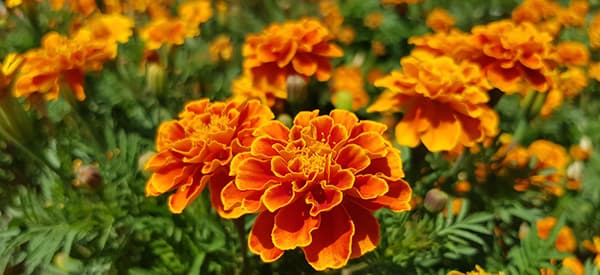
Marigold
Marigold (Tagetes erecta) is a popular flower identifiable by its overpowering smell and lustrous golden bloom. This flower graces the beauty of autumn, but it is also abundant throughout spring and summer. Marigold is every gardener and farmer’s favorite flower routinely planted with crops to keep pesky pests away. Orangey-yellow marigolds are the most common. However, they are also available in red, maroon, or mixed colors. Marigold is a symbol of beauty, warmth, and creativity.
Marigold is the cultural symbol of Nepal and the flowers are made into beautiful garlands. In pre-Hispanic Mexico, flowers were used in the celebration of the dead and are still regarded as a symbol up to this day. Water extract of marigold is traditionally used to wash corpses because of its strong fragrance. This is where it earned the name Flor de Muerto or flower of the dead.
Marigold is either of French or African origin and is indigenous in Mexico and Guatemala. Its botanical name Tagetes is a tribute to the Etruscan deity Tages who came to the Earth with divine powers. The plant was discovered in the 16th century and was introduced to Europe and Northern Africa. They were adopted into gardens and grown for their religious significance.
Where Marigold Is Found
Marigold is a common houseplant cultivated mainly as an ornamental and pest-repellent plant. Escapees from the garden often thrive vigorously in the wild, meadows, and roadsides. Marigold can grow almost everywhere but fares better in evenly moist but well-draining soil. Throughout the world, India, Thailand, and Tanzania are the biggest exporters of various marigold varieties.
How To Identify Marigold
Marigold is a tender, flowering, herbaceous plant naturalized across the world. It is a popular cut flower for making bouquets and garlands that adds a spice of color and feature. They have showy blossoms that grow on slender stems. Some tall varieties are staked to accommodate their nodding flower heads.
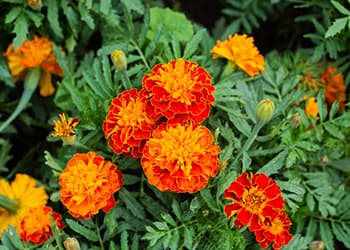
Leaves. Marigold leaves are compounds that may grow in a single primary vein (pinnate), with a secondary leaf branch (bipinnate), or divided into leaflets (palmate). They are green and rough, emitting a strong fragrance when crushed. The leaves are opposite at the bottom and alternate at the top. They appear divided with narrow and toothed lobes.
Flowers. Marigold has different varieties that bear different colored flowers. It ranges from creamy white, yellow, orange, bronze, red, burgundy, and bi-color or variegated. The flowerhead has about 7 to 20 overlapping ray petals and measures about 3 to 6 inches. The petals are smaller and more condensed at the center.
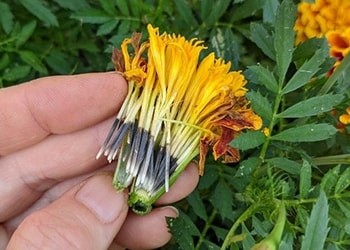 Fruits and seeds. Marigold has achene-type fruit or dry seed pods. It has a feathery seed or pappus made of flat scales that are not frayed at the top. They are black or brown at the bottom with a yellow or white top.
Fruits and seeds. Marigold has achene-type fruit or dry seed pods. It has a feathery seed or pappus made of flat scales that are not frayed at the top. They are black or brown at the bottom with a yellow or white top.
Roots. All varieties of marigolds have fibrous root systems with many equal-sized roots from the base.
Stem. Marigold is herbaceous to woody and exudes a strong aroma when squeezed. They are green, sometimes smooth, or ridged with a round cross-section. It can reach a height of about three to four feet.
⇒ Medicinal Plant Map for Every State (Video)
Tagetes erecta is a plant from the Asteraceae or sunflower family. It shares the same name with Calendula officinalis or pot marigold which is native to Europe, but it is a completely different plant. Tagetes is the genus mostly cultivated for insecticidal properties although lesser for its medicinal uses.
Tagetes are known for names like African marigolds or Mexican marigolds denoting their origin. It is also referred to as common marigold, big marigold, saffron marigold, Mary Bud, or Gold Bloom.
The name Egandai or Gendia, which marigold is also sometimes called, is a reference to its yellow fabric dye. Fresh or dried marigold flowers can dye wool, silk, and other cellulose fibers.
There are about 53 species of Tagetes but the three most valuable species are: Tagetes erecta (Mexican marigold), Tagetes patula, (French marigold) and Tagetes minuta (Southern Cone Marigold)
How To Grow Marigold
Marigold is a prolific spreader that can grow easily from its papery seeds. It is a low-maintenance plant, which makes it a good option for planting on garden edges, containers, or landscaped patios. The plant is generally pest and disease-free and it is also deer resistant.
The most common way of propagating marigolds is growing them from seeds. They do grow from cuttings, but it is rarely done since it takes longer for the cuttings to establish than the seeds to grow. Asexual reproduction is only used in hybrid varieties for achieving the exact duplicate of the plant.
Growing Marigold From Seeds
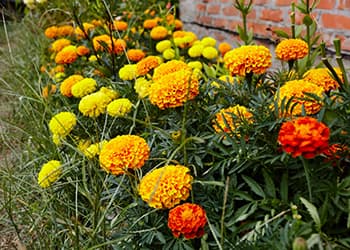 Seeds collected from marigolds are ideal for planting. However, seeds from hybrid plants will not produce a similar color as their parent plant. There might be commercially-sold hybrid varieties with precise genetic heritage you can purchase if you want a specific marigold flower color.
Seeds collected from marigolds are ideal for planting. However, seeds from hybrid plants will not produce a similar color as their parent plant. There might be commercially-sold hybrid varieties with precise genetic heritage you can purchase if you want a specific marigold flower color.
But if you are not concerned about its appearance, you can go on ahead and sow any seeds from the marigold plant.
⇒ Grow This Plant For Extra Income (Video)
Sow marigolds directly in the garden in spring or summer when the soil is already warm. If planting them in winter, start them in seed trays about four to six weeks before the last frost date. Scatter the seeds in a well-draining and rich organic soil and thin the seedlings while still small.
Transplant the established seedlings in the garden at least 10-inches apart.
Growing Marigold From Cuttings
If you want to propagate an exact replica of your hybrid marigold, you can start with a good stem cutting.
Choose a healthy stem and snip off about four-inch segments from the top using a sharp pruner. Remove the flowers and buds leaving only a few leaves on top. Plant the cutting in a moistened potting mix.
Cover the pot with a plastic bag and place it in a warm location but without direct sunlight. Moisten the pot as needed until new roots begin to form. If you feel resistance when pulling the plant, it means that it is already rooted. Remove the plastic bag and continue growing them in full sunlight before transferring them to the garden or its permanent container.
Plant Care And Maintenance
Marigold is a no-fuss plant but will grow better under these growing guidelines:
- Well-draining but moist and fertile soil
- Slightly acidic soil (pH level range of 6 to 6.6)
- Partial shade to full sun
- An inch of water per week
- Deadheading top-heavy plants
Marigolds are excellent insect repellents that can deter mosquitoes, beetles, and other pests. That is why they are often used as companion plants in many types of gardens. However, gardeners should be wary about planting them near legumes. Marigold is toxic to legume crops and may inhibit their growth because of the antibacterial thiophenes that it emits from their roots. It is the same chemical that deters insects and nematodes.
How To Harvest Marigold
When harvesting marigold flowers for flower arrangement, remove the leaves that might be under the water in the vase. You may hang the cut flower to dry if you want to use them for long-lasting arrangements.
If you want to harvest marigold seeds, only do so when the base is brown and the petals are dry. The seeds are the darker end of the achene. Simply pull them away from the base of the flower and allow them to air dry completely for about a week.
⇒ Where to Harvest Free Food in The US (Video)
Store the seeds in a paper envelope instead of a plastic bag to prevent moisture from forming.
What Marigold Is Good For And Natural Remedies Made From It
Marigold has interesting and varied uses aside from being ornamental. For many centuries, it was also used as a medicine and justified by modern scientific research. It contains an effective antibacterial property that combats pathogens in the body.
Internally, marigold is used for treating digestive problems like indigestion, colic, and severe constipation. It was also a traditional herbal medicine for dysentery and fever.
In the past, marigold was used for dispelling intestinal worms with its effective antinematode property.
Using marigold can increase sweating and is best for people with fluid retention.
Marigold is also an excellent herb for respiratory problems such as cough and colds.
Tagetes is an anti-inflammatory and analgesic that can help in managing mumps, sore breast or mastitis, and other inflammations. It can alleviate pain by tricking the pain receptors and inhibiting pain sensation.
⇒ Growing Nature’s Ibuprofen in Your Backyard (Video)
Marigold contains lutein and zeaxanthin, the vital compounds that act as vision detoxifiers. It is believed to benefit eye health and prevent macular degeneration and cataracts.
Other compounds found in marigolds are dihydrotagetone, tagetone, ocimene, and limonene. These are anti-inflammatory, carminative, and diaphoretic compounds useful against rheumatism and peptic ulcer.
Some people may use marigolds externally for treating sores and ulcers. However, they need to do so with caution. This herb has low phototoxicity which can cause burning, blisters, and redness when applied on broken skin and exposed to sunlight.
The antioxidants found in marigolds prevent cancer and tumors. It is also high in vitamin C which helps in preventing and delaying cardiovascular diseases and stroke.
In summary, the uses and effectiveness of marigolds are meant for the following health conditions:
- Digestive complains
- Intestinal worms
- Respiratory illness

- Mumps
- Fluid retention
- Sore eyes, cataracts, and macular degeneration
- Menstrual disorder
- Sore breast
- Kidney problems and urinary infection
- Bacterial infection
- Rheumatism
- Toothache
- Earache
- Bleeding disorders
- Cardiovascular problems
- Myoma, ovarian cyst, mastopathy
What Parts Of Marigold Are Used For Remedies
Marigold is lesser known for its medicinal purpose which is why its supplement form is not widely available in many herbal stores.
For medicinal purposes, the flowers, leaves, petals, and seeds of the plant are used in an herbal preparation. Powdered leaves are taken for urinary problems while the decoction of its leaves can eliminate kidney stones.
Powdered marigold seeds and fresh flower extract are also utilized for other health concerns. Its flowers are used as skin wash while also valued for their yellow dye.
Some farmers use marigolds as chicken feeds to incorporate lutein into the egg. It is said to facilitate the treatment of eye problems.
Commercial marigold supplements are rare, but you may find them as tinctures, ointments, and capsules.
Simple Healing Marigold Tea
Ingredients
- 2 tbsp. dried organic marigold flowers
- 17 fl. oz. water
Steps
- In a saucepan, boil dried marigold flowers in the water for 5 minutes.
- Turn off the heat and infuse for 20 minutes.

- Strain into a teacup and save the rest in a clean jar with a lid.

How To Use This Remedy
Drink about 150 ml of the above marigold tea recipe three times a day for symptom relief.
The dosage for marigold varies. Some juice forms allow only 10 to 20 ml twice a day. Or you may use about 3 to 6 grams when using powder. Always check the labels of the products you are using, or consult with your doctor about allowable dosage since it can interact with your current medications or pre-existing medical conditions.
What Plants Resemble Marigold
| Features | Marigold (Tagetes erecta) | Pot Marigold (Calendula officinalis) | Zinnia (Zinnia elegans) |
|---|---|---|---|
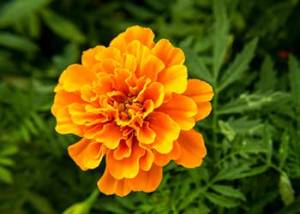 | 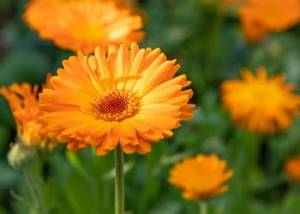 | 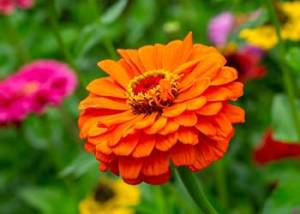 |
|
| Size | 1 to 4 ft | 1 to 2 ft | 6 inches to 3 ft |
| Leaves | Green; rough; compound; alternate to opposite; lance-shaped; lobed; narrowly-toothed | Green; simple; lance to obovate-shaped; with fine hairs | Green; rough; simple; opposite; elliptical; with hairs |
| Flowers | Cream/yellow/orange/ red/variegated; double solitary; head inflorescence; dense petals | Gold/yellow/orange/ burgundy; head inflorescence; single to double flowerheads; darker central disk | Gold/yellow/orange/ pink/burgundy/ lavender; head inflorescence; semi-double to double |
| Fruits/Seeds | Achene; pappus with flat ends; black or brown bottom; yellow or white top | Achene; tiny and green half-moon shaped seeds | Achene; small; elongated; brown; arrowhead-shaped |
| Stem | Erect; green; round; striated; herbaceous to woody | Erect; green; square; branching; | Green; straight; hairy; |
| Scent | Distinctive ketonic or pungent aroma with a fruity undertone | Pungent; hay-like; floral | No scent |
Warnings And Cautions
Tagetes erecta is generally edible, but it has a pungent smell that may not be appetizing at all. It is safe when taken in food amounts and poses no side-effects if taken within the recommended dosage.
Marigold may trigger ragweed allergy in persons sensitive to the plant of this family. Touching the plant may cause skin rashes, eye irritation, sneezing, or runny nose.
The appropriate dose of marigold depends on the user’s health, age, and other conditions. Always consult your doctor and read the package labels when using marigold supplements.
You may also like:
 How to Make The Most Powerful Detox Drink at Home
How to Make The Most Powerful Detox Drink at Home
How Can I Prevent a Urinary Tract Infection? (Video)
The Best Flowers to Attract Beneficial Insects to Your Garden
10 Flowers You Did Not Know You Can Pickle

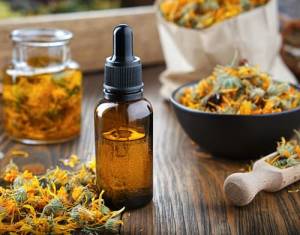
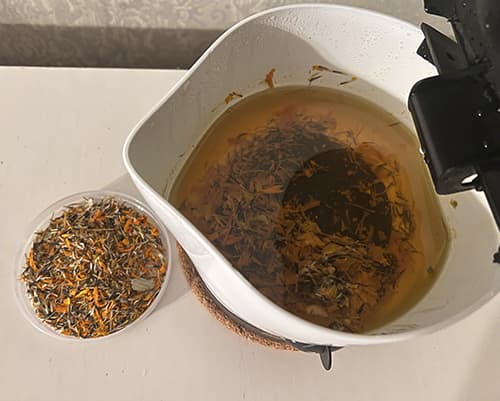
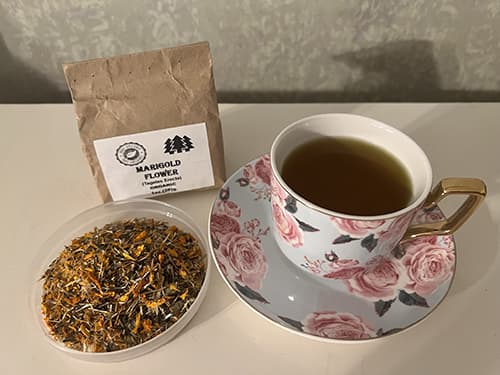
I love all these articles and so relevant to the seasons. Marigold is one of my favorite flowers with such a beautiful smell. Thank you, had no idea I can dry these and use them as a tea for the fall season when kids are back at school and everyone gets sick.
I had read somewhere, that the orange French marigolds were the most potent for repelling pests in the garden. I wonder if that also applies to its other properties (herbal medicinal uses?), when preparing it for these?
Hello Michelle,
Thank you so much for your kind words and appreciation! It’s extremely valuable for us to know that our readers enjoy the articles.
Many blessings and good health!
Thanks
I harvested a some from my South Louisiana Garden last week. Because I have Awfulritus in my hands I thought of an easier way then just pulling or cutting off the whole flower. Using kitchen shears, I gathered the petals with my left hand and with the right hand trimmed the petals at an angle so that the seeds could continue to grow. I looked at the plants this afternoon and they are doing fine. After reading this article, I will harvest many more tomorrow. The large roasting pan of petals dried up to fill a pint jar. I also gave some petals to my favorite old Bantam.
How would I use marigold for my eye health?
Hello Mary,
You can take it as a tea or in supplement form.
Many blessings and good health!
I have just added marigold plants to my vege garden to repel pests and they are growing beautifully. I’m so surprised at all the health benefits and would love to be able to use them fresh out of my garden. Can you advise if they are safe to cut fresh and boil for tea? How many flowers should be used for one cup approximately and is it safe to drink?
I would bet you can google that question and you can probably buy marigold supplements I know you can buy different herbal combinations of teas Marigold tea is often with chamomile teas in combination. I bought some once to help me sleep and marigold helps
Hello Melanie,
We’re glad to hear you love Marigold.
You can try the tea recipe presented in the article. You need: 2 tbsp. dried organic marigold flowers (or 6t tbsp. fresh petals) and 17 fl. oz. water.
In a saucepan, boil the marigold flowers in the water for 5 minutes. Turn off the heat and infuse for 20 minutes. Strain into a teacup and save the rest in a clean jar with a lid. Drink about 150 ml of the above marigold tea recipe three times a day for symptom relief.
The dosage for marigold varies. Some juice forms allow only 10 to 20 ml twice a day. Or you may use about 3 to 6 grams when using powder. Always check the labels of the products you are using, or consult with your doctor about allowable dosage since it can interact with your current medications or pre-existing medical conditions.
Many blessings and good health!
Was it rosemary you can use to wash the eye
Hello Dawn,
Yes, you can make a Rosemary eye wash. Rosemary has been found to protect the eye from macular degeneration and other eye diseases
Many blessings and good health!
I had read that it’s only a specific variety of marigold that is for drinking teas. You have to be careful when you ingest any herb/flower.
Hello Y.
Thank you for your comment. This is why we included the Warnings and Cautions section in the article.
The dosage for marigold varies. Some juice forms allow only 10 to 20 ml twice a day. Or you may use about 3 to 6 grams when using powder. Always check the labels of the products you are using, or consult with your doctor about allowable dosage since it can interact with your current medications or pre-existing medical conditions.
Tagetes erecta is generally edible, but it has a pungent smell that may not be appetizing at all. It is safe when taken in food amounts and poses no side-effects if taken within the recommended dosage.
Marigold may trigger ragweed allergy in persons sensitive to the plant of this family. Touching the plant may cause skin rashes, eye irritation, sneezing, or runny nose.
The appropriate dose of marigold depends on the user’s health, age, and other conditions.
Many blessings and good health!
This article has increased my knowledge of marigolds. It is not a smell that appeals to me but I grow them for the insect benefits. Last summer I cold extracted dried flowers in Olive oil for skin care balms. It produced a beautiful golden orange colour oil.
Hello Nicky,
Thank you for your kind words and for taking the time to share your experience with us!
Marigold oil helps heal the skin from minor burns and injuries and regenerates new skin cells.
Many blessings and good health!
Hi, I purchased your book, I like to know more about eye health and for respiratory issues using Marigold, Thanks, Karola Fischer.
your book is amazing Nicole, but i love this web site. just wondering could you make a marigold ( Tagetes) tincture and if so how much would you take? i assume you could use this as an infused oil also? look forward to your response and again thanks for making this available
This lady knows her stuff. Check her out